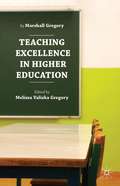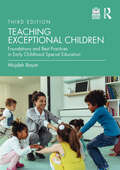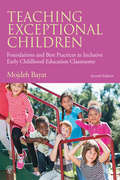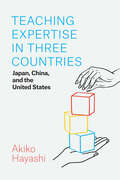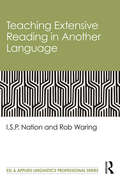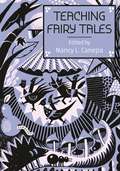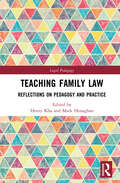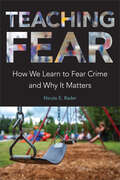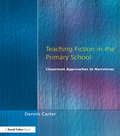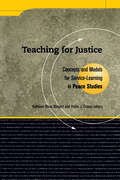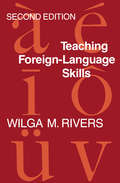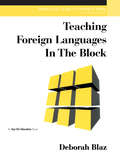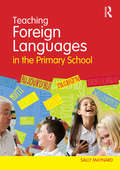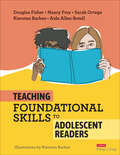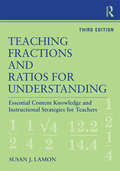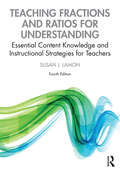- Table View
- List View
Teaching Excellence in Higher Education
by Melissa Valiska GregoryMarshall Gregory argues that teachers at the university and high school levels can achieve teaching excellence by grounding their teaching in pedagogical theory that takes into account students' abilities and the ultimate goals of teaching: to develop students' capacities for thought, reflection, questioning, and engagement to their fullest extent.
Teaching Excellence?: Universities in an age of student consumerism (SAGE Swifts)
by Andrew GunnThis new title explores the role of teaching within the modern university and the impact of the Teaching Excellence and Student Outcomes Framework (TEF). It provides a critical analysis of recent policy reforms designed to increase competition and choice in higher education and what these mean for the sector. It also surveys the wider landscape and the rise of the student as consumer within HE.
Teaching Excellence?: Universities in an age of student consumerism (SAGE Swifts)
by Andrew GunnThis new title explores the role of teaching within the modern university and the impact of the Teaching Excellence and Student Outcomes Framework (TEF). It provides a critical analysis of recent policy reforms designed to increase competition and choice in higher education and what these mean for the sector. It also surveys the wider landscape and the rise of the student as consumer within HE.
Teaching Exceptional Children: Foundations and Best Practices in Early Childhood Special Education
by Mojdeh BayatTeaching Exceptional Children is the ideal textbook for introductory graduate and undergraduate courses on early childhood special education and teaching in inclusive classrooms. Bayat’s clear and accessible writing, the text’s visually appealing design, and the focused pedagogy included in each chapter help make it possible for students and instructors to cover a significant amount of material. This powerful text identifies specific behavioral characteristics and presents theoretical information grounded in neuroscience and child development research for a wide range of disabilities. Chapters provide research-based best practices for effectively working with children with various disabilities in inclusive classrooms. This third edition has been fully updated with recent research and includes new sections on Universal Design for Learning, adaptations, technology, and common challenges in inclusive early childhood classrooms. This book is also accompanied by a robust collection of online resources for instructors and students, providing full support, including a Companion Website featuring an Instructor's Manual with additional ideas for assignments and projects, web and video links with reflection questions, a test bank, and lecture slides; and an eBook+ offering interactive links to videos, glossary terms, and more!
Teaching Exceptional Children: Foundations and Best Practices in Inclusive Early Childhood Education Classrooms
by Mojdeh BayatTeaching Exceptional Children is an ideal textbook for introductory graduate and undergraduate courses on early childhood special education and teaching in inclusive classrooms. Bayat’s clear and accessible writing, a visually appealing design, and focused pedagogy in each chapter help make it possible to cover a significant amount of material. This powerful text identifies specific behavioral characteristics and presents theoretical information grounded in neuroscience and child development research for a wide range of disabilities. Research-based best practices for effectively working with children with various disabilities in inclusive classrooms are provided in each chapter. The second edition has been fully updated based on the DSM-5, and includes new sections on contemporary issues in inclusion of children with disabilities in early childhood classrooms, such as challenging behaviors, using technology, at-risk children, promoting mental health, and family issues. A robust pedagogical program, along with online resources for instructors and students, provides full support, including: Chapter Objectives and Key Terms help frame each chapter Discussion, Critical Thinking, Essay/Short Answer, and Review Questions at the beginning, throughout, and concluding chapters prompt students to fully engage with the material Homework/Field Assignments provide opportunities for students to apply their knowledge to real-world situations Real-Life Vignettes illustrate concepts in action Color Photos, Figures, and Tables clarify concepts in a visually engaging way Recommended Resources and References offer guidance for further study www.routledge.com/9781138802209 includes a link to an Instructor's Manual with ideas for assignments and projects, grading and assessment rubrics, and learning outcomes (see the e-Resource tab). A full companion website (www.routledge.com/cw/bayat) is under construction and will provide video and web links, discussion questions, test bank, PowerPoints, and a sample syllabus.
Teaching Expertise in Three Countries: Japan, China, and the United States
by Akiko HayashiA comparison of the development of expertise in preschool teaching in China, Japan, and the United States. In Teaching Expertise in Three Countries, Akiko Hayashi shows how teachers from Japan, China, and the United States think about what it means to be an expert teacher. Based on interviews with teachers conducted over the span of fifteen years and videos taken in their classrooms, Hayashi gives us a valuable portrait of expert teachers in the making. While Hayashi’s research uncovered cultural variations in the different national contexts, her analysis of how teachers adapted their pedagogy throughout their careers also revealed many cross-national similarities. Younger teachers often describe themselves as being in a rush, following scripts, and “talking too much,” while experienced teachers describe themselves as being quieter, knowing children better, and being more present. Including a foreword by scholar of early childhood education Joseph Tobin, Teaching Expertise in Three Countries provides a foundation for understanding the sequence and pathways of development over the first decade of teaching in three national contexts, demonstrating the value of the field of comparative education in the process.
Teaching Extensive Reading in Another Language (ESL & Applied Linguistics Professional Series)
by I.S.P. Nation Rob WaringThis comprehensive book by renowned scholars Paul Nation and Rob Waring accessibly covers all aspects of extensive reading in second and foreign language contexts. The book serves as a major update to the field on the topic, with current research findings on extensive reading as they relate to motivation, reading fluency, and vocabulary learning, among other topics. Clear and straightforward, it includes case studies, strategies, and methods for implementing and assessing effective extensive reading in the classroom and provides resources and tools for preservice teachers of ESL/EFL and foreign languages. Suitable for programs in TESOL and Applied Linguistics with courses in L2 reading, reading instruction, TESOL methods, and foreign language reading or teaching, it will appeal to students and preservice teachers as well as English language teaching professionals and EFL/ESL teachers.
Teaching Fairy Tales (Series in Fairy-Tale Studies)
by Gioia Timpanelli Cristina Mazzoni Allison Stedman Ann Schmiesing Jennifer Schacker Prof. Nancy L. Canepa Prof. Jack Zipes Dean Donald Haase Lewis C. Seifert Prof. Anne E. Duggan Professor Maria Nikolajeva Prof. Cristina Bacchilega Associate Professor Christine A. Jones Julie L. Koehler Kay Stone Prof. Maria Tatar Prof. Victoria Somoff Prof. Gina Miele Prof. Linda Kraus Worley Prof. Faith E. Beasley Prof. Charlotte Trinquet du Lys Prof. Benjamin Balak Prof. Suzanne Magnanini Dr Maria Kaliambou Prof. Elio Brancaforte Prof. William Moebius Prof. Graham AndersonTeaching Fairy Tales edited by Nancy L. Canepa brings together scholars who have contributed to the field of fairy-tale studies since its origins. This collection offers information on materials, critical approaches and ideas, and pedagogical resources for the teaching of fairy tales in one comprehensive source that will further help bring fairy-tale studies into the academic mainstream. The volume begins by posing some of the big questions that stand at the forefront of fairy-tale studies: How should we define the fairy tale? What is the "classic" fairy tale? Does it make sense to talk about a fairy-tale canon? The first chapter includes close readings of tales and their variants, in order to show how fairy tales aren’t simple, moralizing, and/or static narratives. The second chapter focuses on essential moments and documents in fairy-tale history, investigating how we gain unique perspectives on cultural history through reading fairy tales. Contributors to chapter 3 argue that encouraging students to approach fairy tales critically, either through well-established lenses or newer ways of thinking, enables them to engage actively with material that can otherwise seem over-familiar. Chapter 4 makes a case for using fairy tales to help students learn a foreign language. Teaching Fairy Tales also includes authors’ experiences of successful hands-on classroom activities with fairy tales, syllabi samples from a range of courses, and testimonies from storytellers that inspire students to reflect on the construction and transmission of narrative by becoming tale-tellers themselves. Teaching Fairy Tales crosses disciplinary, historical, and national boundaries to consider the fairy-tale corpus integrally and from a variety of perspectives. Scholars from many different academic areas will use this volume to explore and implement new aspects of the field of fairy-tale studies in their teaching and research.
Teaching Family Law: Reflections on Pedagogy and Practice (Legal Pedagogy)
by Henry Kha and Mark HenaghanThis book provides a comprehensive analysis of the teaching of an eclectic range of family law topics and the unique opportunities and challenges of teaching family law in different jurisdictions from a varied international perspective. Written by leading legal scholars, the book addresses a gap in the scholarship to comprehensively and systematically analyse the teaching of family law. The first part of the book explores ways of teaching the varied range of topics under the heading of family law and captures the diverse approaches to the discipline. Chapters illustrate how the subject can be best taught in an interdisciplinary way that considers feminist perspectives and the philosophy of teaching, while encompassing legal positivism, empirical research and critical legal theory. The second part of the book examines teaching in different jurisdictions and illustrates policy and practice in Australia, New Zealand, the United States, Canada, the United Kingdom, Hong Kong and South Africa. Showcasing examples of best practice of teaching family law, the book will be an essential reading for legal scholars, as well as researchers and postgraduate students in the fields of family law and legal education.
Teaching Fear: How We Learn to Fear Crime and Why It Matters
by Nicole E. RaderWhere do lessons of “stranger danger” and safety come from—and do they apply differently for women? A gender-fear paradox shows that although women are less likely to be victims of most crimes (sexual assault aside), their fear of crime is greater. Moreover, girls and women—especially White women—are taught to fear the wrong things and given impossible tools to prevent victimization. In Teaching Fear, Nicole Rader zooms in on the social learning process, tracing the ways that families, schools, and the media have become obsessed with crime myths, especially regarding girls and women. Based on in-depth research and family studies, Rader reveals the dubious and dangerous origins of many of the most prominent safety guidelines that teach young girls to be more afraid of crime. These guidelines carry over to adulthood, influencing women’s behaviors and the way they order their worlds, with dangerous consequences. As women teach their learned behavior and conditioned fear to others, gendered crime myths are recirculated from generation to generation, making them a staple in our society. Teaching Fear includes suggestions for taking precautionary measures and crime prevention strategies. Rader also provides guidance for instilling safety values and demonstrating how we can “teach fear better” to break this cycle and truly create greater security.
Teaching Fear: How We Learn to Fear Crime and Why It Matters
by Nicole E. RaderWhere do lessons of “stranger danger” and safety come from—and do they apply differently for women? A gender-fear paradox shows that although women are less likely to be victims of most crimes (sexual assault aside), their fear of crime is greater. Moreover, girls and women—especially White women—are taught to fear the wrong things and given impossible tools to prevent victimization. In Teaching Fear, Nicole Rader zooms in on the social learning process, tracing the ways that families, schools, and the media have become obsessed with crime myths, especially regarding girls and women. Based on in-depth research and family studies, Rader reveals the dubious and dangerous origins of many of the most prominent safety guidelines that teach young girls to be more afraid of crime. These guidelines carry over to adulthood, influencing women’s behaviors and the way they order their worlds, with dangerous consequences. As women teach their learned behavior and conditioned fear to others, gendered crime myths are recirculated from generation to generation, making them a staple in our society. Teaching Fear includes suggestions for taking precautionary measures and crime prevention strategies. Rader also provides guidance for instilling safety values and demonstrating how we can “teach fear better” to break this cycle and truly create greater security.
Teaching Fiction in the Primary School: Classroom Approaches to Narratives
by Dennis CarterFirst Published in 2000. Routledge is an imprint of Taylor & Francis, an informa company.
Teaching Fiercely: Spreading Joy And Justice In Our Schools
by Kass MinorRevolutionize the way you negotiate the realities of childhood education In Teaching Fiercely: Spreading Joy and Justice in Our Schools, accomplished educator Kass Minor delivers an inspiring and practical exploration of what it means to be a just teacher in a system that actively incentivizes injustice. The author explains how to build joyful experiences even in the face of inevitable injustice and demonstrates how to accept the seemingly conflicting experience of joy in the face of heartbreak. In the book, you'll learn to be a catalyst for change, unlearning the patterns of school that have marginalized children while becoming aware of tenets of justice as they manifest in educational spaces. You'll also discover: Strategies for creating human-centered care and joy, in which thoughts, actions, and decisions are drawn from within the school community Techniques for creating student-centered experiences within standards-based classrooms How to raise the level of family involvement in your students' education and improve communication between family and staff An essential blueprint for K-12 educators, school support staff, and school administrators, Teaching Fiercely will also earn a place on the bookshelves of education policymakers, researchers, and students.
Teaching Film (Options for Teaching #35)
by Patricia White Mark Lynn Anderson Adam Lowenstein Hamid Naficy Dudley Andrew Timothy Corrigan Anne Rutherford Tasha Oren Garrett Stewart E. Ann Kaplan Gwendolyn Audrey Foster Michael Renov Pat Brereton David Desser Maureen Turim Paula J. Massood Michael Aronson Nataša Ďurovičová Mark LangerFilm studies has been a part of higher education curricula in the United States almost since the development of the medium. Although the study of film is dispersed across a range of academic departments, programs, and scholarly organizations, film studies has come to be recognized as a field in its own right. In an era when teaching and scholarship are increasingly interdisciplinary, film studies continues to expand and thrive, attracting new scholars and fresh ideas, direction, and research.Given the dynamism of the field, experienced and beginning instructors alike need resources for bringing the study of film into the classroom. This volume will help instructors conceptualize contemporary film studies in pedagogical terms. The first part of the volume features essays on theory and on representation, including gender, race, and sexuality. Contributors then examine the geographies of cinema and offer practical suggestions for structuring courses on national, regional, and transnational film. Several essays focus on interdisciplinary approaches, while others describe courses designed around genre (film noir, the musical), mode (animation, documentary, avant-garde film), or the formal elements of film, such as sound, music, and mise-en-scène. The volume closes with a section on film and media in the digital age, in which contributors discuss the opportunities and challenges presented by access to resources, media convergence, and technological developments in the field.
Teaching Film from the People's Republic of China (Options for Teaching)
by Zhuoyi Wang, Emily Wilcox, and Hongmei YuThis volume brings a diverse range of voices--from anthropology, communication studies, ethnomusicology, film, history, literature, linguistics, sociology, theater, and urban geography--into the conversation about film from the People's Republic of China. Essays seek to answer what films can reveal or obscure about Chinese history and society and demonstrate how studying films from the PRC can introduce students to larger issues of historical consciousness and media representation.The volume addresses not only postsocialist fictional films but also a wide variety of other subjects including socialist period films, documentaries, films by or about people from ethnic minority groups, film music, the perspectives of female characters, martial arts cinema, and remakes of South Korean films. By exploring how films represent power, traditions, and ideologies, students learn about both the complexity of the PRC and the importance of cross-cultural and cross-ideological understanding.
Teaching Food Technology in Secondary School (Roehampton Teaching Studies)
by Marion RutlandFirst Published in 1997. Routledge is an imprint of Taylor & Francis, an informa company.
Teaching For Justice: Concepts and Models for Service Learning in Peace Studies
by Robin J. Crews Kathleen Maas WeigertTenth in the Service-Learning in the Disciplines Series, this book shows how both peace studies and service-learning have been developing new ideas of how social learning takes place as a community process in conflict situations and what the dynamics of peace building are. The process has created a new niche in academia for preparing students to become social change agents. The enthusiasm of the contributors in this book gives the reader a new vision of what is possible on college campuses in community-based peace and service-learning at a time when there is a critical need for peace-building skills.
Teaching Foreign Language Skills
by Wilga M. RiversSince its original publication in 1968, Rivers's comprehensive and practical text has become a standard reference for both student teachers and veteran instructors. All who wish to draw from the most recent thinking in the field will welcome this new edition. Methodology is appraised, followed up by discussions on such matters as keeping students of differing abilities active, evaluating textbooks, using language labs creatively, and preparing effective exercises and drills. The author ends each chapter of this new edition with questions for research and discussion—a useful classroom tool—and provides an up-to-date bibliography that facilitates further understanding of such matters as the bilingual classroom.
Teaching Foreign Languages in the Block
by Deborah BlazProvides detailed instructional strategies, sample lesson plans, and sample assessments so that foreign language teachers can make the best use of the additional time.
Teaching Foreign Languages in the Primary School
by Sally MaynardTeaching Foreign Languages in the Primary School is for every teacher –whether generalist or specialist, trainee or experienced – wanting to confidently introduce foreign language teaching into their classroom. Based on the author’s extensive experience of teaching across Key Stages 1-2, this book provides practical strategies that can be easily implemented in your setting. Offering comprehensive guidance on the pedagogy that underpins language teaching, it covers everything you’ll need to teach foreign languages effectively: Planning, teaching and assessment Pedagogical approaches Integrating primary languages across the curriculum Where to find and how to use good resources Using TAs effectively to support language learning Inclusive practice Using ICT in language teaching How to promote children’s intercultural understanding Illustrated with useful lesson ideas and a range of examples from the classroom, Teaching Foreign Languages in the Primary School is an indispensable source of support for all student and practising primary school teachers.
Teaching Foundation Mathematics: A Guide for Teachers of Older Students with Learning Difficulties (nasen spotlight)
by Nadia Naggar-SmithThis fully photocopiable resource will provide essential materials for anyone teaching pre-entry or foundation Maths in secondary schools and further education. Teaching Foundation Mathematics is developed to provide age appropriate material for adult learners with moderate to severe learning difficulties and/or disabilities and for children, over twelve, with special needs. It will also prove useful to teachers training to work with these learners. Thirty ready-to-use lessons are at your fingertips in this book, complete with tutor’s notes, teaching objectives, detailed lesson plans and photocopiable worksheets, where appropriate. The lessons are divided into three areas – number, shape and measure.
Teaching Foundational Skills to Adolescent Readers
by Douglas Fisher Nancy Frey Sarah Ortega Kierstan Barbee Aida Allen-RotellRecharge Adolescent Literacy: Strategies to Foster Joyful and Proficient Readers There are many adolescent readers who, for a variety of reasons, find it difficult to connect with written words and have fallen behind on their foundational reading skills. Thankfully, it’s never too late to give these necessary skills a boost and help students find joy in reading and learning. Armed with equity, empathy, evidence-based research, and practical application, Teaching Foundational Skills to Adolescent Readers provides classroom practices teachers can use with the whole class or with small groups to integrate reading support seamlessly with grade-level content learning. Bestselling authors Douglas Fisher and Nancy Frey, along with Sarah Ortega, Kierstan Barbee, and Aida Allen-Rotell, creatively organize the book around a metaphor: adolescent literacy is a battery—when all the parts are connected, working together, and fully charged—literacy can thrive. Throughout the book, the following features will guide your learning: Plug Into the Research – an overview of the evidence-based research supporting each section of the literacy model Power Up Classroom Practice – connecting the dots on the research, classroom practice and human aspects of learning Voices from the Field – classroom examples of application and strategies from other secondary educators Take Charge – key takeaways and reflection questions Tips on building and organizing your classroom library to incorporate tools, technology, and media available to maximize lesson effectiveness Dozens of videos to model time-efficient strategies and key concepts By focusing on research, classroom practices, and the human aspects of learning, this book is an essential tool to recharge reading practices for adolescent readers and help educators increase foundational reading skills in the classroom.
Teaching Foundational Skills to Adolescent Readers
by Douglas Fisher Nancy Frey Sarah Ortega Kierstan Barbee Aida Allen-RotellRecharge Adolescent Literacy: Strategies to Foster Joyful and Proficient Readers There are many adolescent readers who, for a variety of reasons, find it difficult to connect with written words and have fallen behind on their foundational reading skills. Thankfully, it’s never too late to give these necessary skills a boost and help students find joy in reading and learning. Armed with equity, empathy, evidence-based research, and practical application, Teaching Foundational Skills to Adolescent Readers provides classroom practices teachers can use with the whole class or with small groups to integrate reading support seamlessly with grade-level content learning. Bestselling authors Douglas Fisher and Nancy Frey, along with Sarah Ortega, Kierstan Barbee, and Aida Allen-Rotell, creatively organize the book around a metaphor: adolescent literacy is a battery—when all the parts are connected, working together, and fully charged—literacy can thrive. Throughout the book, the following features will guide your learning: Plug Into the Research – an overview of the evidence-based research supporting each section of the literacy model Power Up Classroom Practice – connecting the dots on the research, classroom practice and human aspects of learning Voices from the Field – classroom examples of application and strategies from other secondary educators Take Charge – key takeaways and reflection questions Tips on building and organizing your classroom library to incorporate tools, technology, and media available to maximize lesson effectiveness Dozens of videos to model time-efficient strategies and key concepts By focusing on research, classroom practices, and the human aspects of learning, this book is an essential tool to recharge reading practices for adolescent readers and help educators increase foundational reading skills in the classroom.
Teaching Fractions and Ratios for Understanding: Essential Content Knowledge and Instructional Strategies for Teachers
by Susan J. LamonFor over a decade, Teaching Fractions and Ratios for Understanding has pushed readers beyond the limits of their current understanding of fractions and rational numbers, challenging them to refine and explain their thinking without falling back on rules and procedures they have relied on throughout their lives. All of the material offered in the book has been used with students, and is presented so that readers can see the brilliance of their insights as well as the issues that challenge their understanding. Written in a user-friendly, conversational style, this text helps teachers build the comfort and confidence they need to begin talking to children about fractions and ratios. The clear distillation of complex ideas and the translation of research into usable ideas for the classroom make this text a valuable resource for all pre- and in-service mathematics teachers. The highly anticipated third edition of this popular text has been heavily expanded and reorganized to make the connectivity of topics even more transparent, including more mathematics content, teaching/reasoning techniques, classroom activities, connections to other content, and applications to everyday life. In addition, the most effective features from previous editions have been retained. Special Features: Children’s Strategies and samples of student work are provided in each chapter for teacher analysis. Activities for practicing the thinking strategies explained in each chapter, designed to be solved without rules or algorithms, using reasoning alone. Online Resources for Instructors including a sample syllabus, chapter overviews and relevant Big Content ideas for each chapter, and graphics that can be copied and resized for use in instruction and in constructing exams. An equally valuable component of this text is MORE! Teaching Fractions and Ratios for Understanding, Third Edition---a supplement that is not merely an answer key but a resource that provides the scaffolding for this groundbreaking approach to fraction and ratio instruction. Also heavily expanded, MORE! includes in-depth discussions of selected problems in the main text, supplementary activities, Praxis preparation questions, more student work, and templates for key manipulatives.
Teaching Fractions and Ratios for Understanding: Essential Content Knowledge and Instructional Strategies for Teachers
by Susan J. LamonWritten in a user-friendly, conversational style, the fourth edition of this groundbreaking text helps pre-service and in-service mathematics teachers build the comfort and confidence they need to begin talking to children about fractions and ratios, distilling complex ideas and translating research into usable ideas for the classroom. For two decades, Teaching Fractions and Ratios for Understanding has pushed readers beyond the limits of their current understanding of fractions and rational numbers, challenging them to refine and explain their thinking without falling back on rules and procedures they have relied on throughout their lives. All of the material offered in the book has been used with students, and is presented so that readers can see the brilliance of their insights as well as the issues that challenge their understanding. Each chapter includes children’s strategies and samples of student work for teacher analysis, as well as activities for practicing each thinking strategy, designed to be solved without rules or algorithms, using reasoning alone. The fourth edition of this popular text has been updated throughout and includes new examples of student work, updated artwork, and more. As with previous editions, an equally valuable component of this text is the companion book MORE! Teaching Fractions and Ratios for Understanding (2012), a supplement that is not merely an answer key but a resource that provides the scaffolding for the groundbreaking approach to fraction and ratio instruction explored here. MORE! includes in-depth discussions of selected problems in the main text, supplementary activities, Praxis preparation questions, more student work, and templates for key manipulatives.
